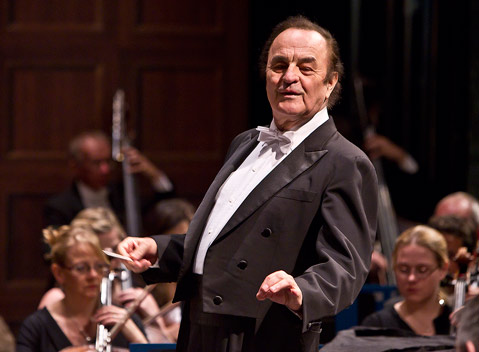The Royal Philharmonic at the Granada Theatre
With Jean Yves Thibaudet, Piano, and Charles Dutoit Conducting

CAMA continued its Season of the Century-dubbed International Series on Thursday with the Royal Philharmonic under the baton of Swiss maestro Charles Dutoit. Dutoit’s traditional style was well suited to the program, which hewed to the familiar musical path that leads from Hungary through Austria, Germany, and France. Things began in Galánta, a small Hungarian market town on the road between Budapest and Vienna. At least that’s where composer Zoltán Kodály had in mind when he composed his folk-influenced Dances of Galánta back in 1933. Audience members were split over the value of the composition — some found it ravishing, while others were less enthusiastic, especially about the hazy Hungarian structure — but were unanimously in favor of the orchestra’s bold, rich tone, especially in the strings and brass. Michael Whight played the clarinet solos in a suitably Bartókian vein.
Jean-Yves Thibaudet is as in-demand as any pianist in the world right now, and it’s easy to see why. Santa Barbara concertgoers may remember his brilliant Arts & Lectures-sponsored Liszt recital in February 2011, and fans of the PBS Great Performances series may recognize him from the New York Philharmonic’s splendid New Year’s Eve Gala 2011-12, in which he performed George Gershwin’s Rhapsody in Blue. With his platinum hair, Vivienne Westwood suits, and general air of bling, once one has seen Thibaudet, there’s no forgetting him. Fortunately, his playing is even more memorable than his appearance, and conspicuously lacking in sensationalism. It’s a steely, no-nonsense approach that Thibaudet typically takes, and the results, at least with such “some-nonsense” compositions as the Piano Concerto No. 2 in A Major, S. 125 of Franz Liszt, are remarkable. Royal Phil principal cellist Louisa Tuck played beautifully all night, but she soared particularly high during her duet with Thibaudet in this concerto. Thibaudet excelled at delivering the piece’s many rapid, percussive runs without sacrificing detail.
After the interval, the orchestra focused on the vigorous gyrations of Maestro Dutoit, who could be said to have danced the musicians through a sharp and rhythmically savvy reading of Brahms’s deceptively difficult Symphony No. 1 in C Minor, Op. 68. This warhorse might be the most popular orchestral work on the planet right now — it’s been played at the Granada by at least three different orchestras in the last year. The Royal Phil showed that they know how to open it up and make the big moments count, sounding great even through some misfires from the horns. Dutoit, in particular, managed the tempo very effectively, giving the audience an unusually nuanced account of Brahms’s sophisticated rhythmic devices in the final movements, something that even other top orchestras sometimes fail to do.
Orchestral programming can seem tame, especially when compared with the consistently adventurous decisions available to the promoters of chamber music. But the repertoire, no matter how it may shrink, remains a fantastic resource in the hands of these great symphonies, with their decades and even centuries of history and musical culture. The standard version of what distinguishes great British orchestras like the Royal Philharmonic from their American counterparts is a sense of ease in the execution of difficult material, and this orchestra, especially with the assistance of a technical virtuoso of Thibaudet’s gifts, demonstrated that their reputation for elegance and musicality is well deserved.



